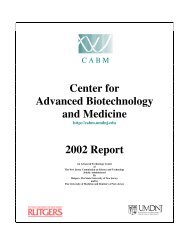Annual Report 2011 - Center for Advanced Biotechnology and ...
Annual Report 2011 - Center for Advanced Biotechnology and ...
Annual Report 2011 - Center for Advanced Biotechnology and ...
You also want an ePaper? Increase the reach of your titles
YUMPU automatically turns print PDFs into web optimized ePapers that Google loves.
Dr. Masayori Inouye<br />
CABM Resident Faculty Member<br />
Distinguished Professor<br />
Department of Biochemistry<br />
UMDNJ-Robert Wood Johnson<br />
Medical School<br />
Dr. Sangita Phadtere<br />
Adjunct Associate Professor<br />
Yojiro Ishida<br />
Research Associate<br />
Hiroshi Kobayashi<br />
Research Associate<br />
Dr. Lili Mao<br />
Research Associate<br />
Dr. Yoshihiro<br />
Yamaguchi<br />
Research Associate<br />
Dr. Kuen-Phon Wu<br />
Postdoctoral Associate<br />
Dr. Hisako Masuda<br />
Postdoctoral Fellow<br />
Yu-Jen Chen<br />
Graduate Student<br />
Chun-Yi Lin<br />
Graduate Student<br />
Bacterial Physiology <strong>and</strong> Protein Engineering Laboratory<br />
Dr. Masayori Inouye joined CABM in October 2009. He is well-known <strong>for</strong><br />
his discovery of antisense-RNA in 1984, the function of the signal peptide <strong>for</strong><br />
secretion, biogenesis of outer membrane proteins, propeptide-mediated<br />
protein folding <strong>and</strong> molecular biology of histidine kinases. Currently he is<br />
working on the characterization of the toxin-antitoxin (TA) systems from E.<br />
coli <strong>and</strong> human pathogens such as Mycobacterium tuberculosis <strong>and</strong><br />
Staphylococcus aureus. The discovery of a sequence (ACA)-specific<br />
endoribonuclease from the E. coli TA systems led his laboratory to develop a<br />
unique protein production system converting E. coli cells to a single-protein<br />
production (SPP) bioreactor. This system allows one to label only a protein<br />
of interest in the cells with a specific isotope(s), an amino acid(s) or a toxic<br />
non-natural amino acid analogue(s) in a high yield. His laboratory also<br />
does research on the mechanism of ribosome stalling during protein<br />
synthesis. In May <strong>2011</strong>, he received the Edward J. Ill Excellence in Medicine<br />
Award <strong>for</strong> Outst<strong>and</strong>ing Medical Research Scientist. Dr. Inouye is a member<br />
of the American Academy of Arts & Sciences.<br />
Toxin-antitoxin (TA) systems; their roles in bacterial physiology <strong>and</strong> the<br />
development of novel antibiotics<br />
Almost all bacteria including human pathogens contain suicide or toxin genes which<br />
are induced under stress conditions leading to cell growth arrest <strong>and</strong> eventual cell<br />
death in a way similar to apoptosis or programmed cell death in higher systems.<br />
Escherichia coli contains at least 35 TA systems <strong>and</strong> their toxins are highly diverse,<br />
targeting DNA, mRNA, protein <strong>and</strong> cell wall synthesis. The importance of these TA<br />
systems in medical science has not been fully appreciated until recently. The Inouye<br />
laboratory works to decipher the cellular targets of these toxins <strong>and</strong> the molecular<br />
mechanisms of toxin functions.<br />
Promoter<br />
ATP-dependent<br />
proteases<br />
Antitoxin<br />
Toxin<br />
Cellular targets<br />
Bacterial Toxin-Antitoxin (Apoptosis) System<br />
Protein<br />
DNA<br />
15



